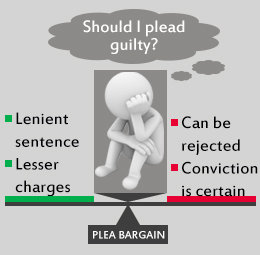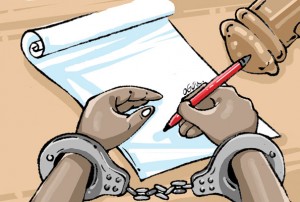In this blog post, Abhiraj Thakur, a student of NALSAR University of Law, Hyderabad highlights the major differences in the procedure of plea bargaining in India in comparison to that in USA. He also explains how the Indian model of plea bargaining, though a derivative of the US model, has evolved over the course of time to avoid the shortcomings that the US model suffers from.
Plea bargaining refers to the concessions that a defendant receives when he pleads guilty to the crimes he has been charged with. It’s a voluntary transaction that must take place with the consent of both the parties concerned. Broadly, there are two kinds of plea bargaining, charge bargaining and sentence bargaining. In charge bargaining, the defendant pleads guilty to a less serious offence or to one of many charges, in exchange for the dropping of the other charges. Sentence bargaining, which is the kind that is followed in India, is the form wherein the accused pleads guilty in exchange for a concession on the sentence.[1]
While plea bargaining has been the subject matter of a lot of discussion in various Indian courts since the 1970s itself, it was formally incorporated into the Code of Criminal Procedure (CrPC) in 2005 as Chapter XXIX through the Criminal Law (Amendment) Act, 2005. Drawing on the recommendations of the Malimath Committee Report, while it is premised on the American model, it is significantly different.
Plea Bargaining Under CRPC
These recommendations were incorporated in the CrPC through the Criminal Law (Amendment) Act 2005. Sections 265A to 265L under chapter XXI now deal with plea bargaining which is significantly different from the scheme followed by American Law. As per the CrPC, the onus to invoke the provisions of plea bargaining is on the accused.[2] Only those accused of offences whose punishment is less than seven years imprisonment and/or fine, and which do not fall under the category of socio-economic offences or crimes against women and children can apply under the given provision.[3] Further, only first time offenders can avail this provision.[4] The procedure is fairly straightforward. Once the application is made, it is submitted to the judge along with an affidavit[5] who will examine the accused in camera to ascertain the voluntariness of the application.[6] Once the judge is satisfied with the voluntariness of the accused’s plea, he gives the accused, the public prosecutor and the victim (and the Investigating officer if the case was made through a police report) time to come to a mutually satisfactory resolution.[7] Guidelines are given for arriving at a mutually satisfactory conclusion, which must be presented before the court. The sentence may be reduced to half or to a fourth of the sentence that had been provided for as per the statute.[8] The judge will then serve the reduced sentence upon the accused, pronouncing his judgement in open court.[9] The accused may also have to give some amount as compensation or cover the victim’s legal expenses.[10] The accuser’s statements will not be admissible anywhere else[11] and there is no provision for an appeal except by special leave petition under article 136 and by writ petitions under article 226 and 226 of the constitution.[12]
The provision as contemplated by the CrPC are significantly at odds with the model that was proposed by the Law Commission, which had suggested the constitution of a “competent authority” who would act as a plea judge for offences that were punishable with imprisonment for seven years or less. In case of other offences, two retired judges of the High Court who would be appointed by the Chief Justice of the High Court in consultation with two of his senior most colleagues, are to decide on merits whether such plea should be allowed for that particular offence. Such a scheme does not leave any scope for any wrongdoings or underhand dealings and provides for greater judicial discretion. The prosecutor and the victim would be involved only to the extent of putting forth their version of the story in front of the requisite authority. Hence, this proposal was not based on the traditional understanding of plea bargaining but only sought to formally acknowledge the practice of showing judicial leniency to those who pleaded guilty.[13]
American Model Vs Indian Model
Plea Bargaining was upheld as constitutional in United States in the case of Brady v. United States.[14] Plea bargaining is heavily entrenched in the American criminal administration. There are three kinds of pleadings that are accepted by the US courts: the accused can plead guilty, not guilty or nolo contendere. Plea bargaining is based on the plea of nolo contendere which, as per Fox v. Schedit and State Exrel Clark v. Adam, is a quasi-confession. It is not an inherent right afforded to the accused, but once given by the court it cannot be conditional or retracted in any manner.[15] Essentially, in relation to punishment, it carries the same implications as a guilty plea, but subsequently, it is not admissible to establish guilt in the subsequent cases.
The Indian version of pleas bargaining leans heavily on the American provisions. However, there are a few significant differences between the Indian and the American scheme of plea bargaining:
- Firstly, in U.S.A, there is no restriction or limitation on the kind of offences for which plea bargaining can be sought. Plea bargaining may be applied for even in offences that carry a sentence of death penalty or life imprisonment. Further, Indian law implies that the victim has an active say in the bargaining proceedings, and may refuse or veto an unsatisfactory resolution. These differences are significant in the sense that they help the Indian model avoid certain pitfalls that plea bargaining is identified with.
- Secondly, in America, an application for plea bargaining is filed only after negotiations between the accused and the prosecutor is over. However in India, the onus is on the defendant to file an application for plea bargaining. This is a safeguard for the accused and helps in preventing cases of coercion and underhand dealings.
- Further, there is a provision for the court to ascertain the voluntariness of the application. This too is an important safeguard, taking into account the socio-economic groups that are an intrinsic part of Indian society. It means that the judge can reject a plea bargaining application if he is of the view that there is prima facie no case against the accused, or if he feels that that the accused is getting away with a punishment that is less than what should be due, to the extent that it defeats the purpose of criminal justice or a disparity in the socio-economic status is being exploited to arrive at the bargain.
There was much debate before the incorporation of plea bargaining, since the courts were vehemently opposed to it. In Muralidhar Meghraj Loya v. State of Maharastra[16], Justice Krishna Iyer observed,
Call plea bargaining‘, plea negotiation‘, trading out‘ and compromise in criminal cases‘ and the trial magistrate drowned by a docket burden nods assent to the sub rosa anteroom settlement. The businessman culprit, confronted by a sure prospect of the agony and ignominy of tenancy of a prison cell, trades out ‘of the situation, the bargain being a plea of guilt, coupled with a promise of no jail’. These advance arrangements please everyone except the distant victim, the silent society.
However, a closer inspection reveals the background of this observation. Justice Iyer’s apprehensions have been mitigated to a great deal with the model that was implemented finally. The offence in question was in relation to food adulteration which had widespread health ramifications. However, with the provisions of the CrPC, socio-economic offences are omitted from the purview of the plea bargaining so if any offence has a broad spectrum effect, the option of plea bargaining will not be available. Secondly, plea bargaining does not always imply that the accused will not be jailed. He will still be punished, and his reduced sentence cannot be lesser than half or one fourth as the case may be.[17]
The rationale behind the introduction of plea bargaining in India was its efficacy in disposing off cases quickly and hence substantially reducing in the backlog problem. The courts have long maintained that justice delayed is justice denied. However, the Indian courts are plagued with a systemic case of backlogs. Plea bargaining certainly seems like an expeditious and efficient device to solve this problem; however it is yet to become popular. Although the legislature has been extremely cautious in its approach towards it and has succeeded in circumventing some of the issues that are associated with plea bargaining, there is still some scope for improvement to make it not only administratively efficient, but also procedurally fair and just.
[1] K.V.K. Santhy, Plea Bargaining In US And Indian Criminal Law Confessions For Concessions, NALSAR LAW REVIEW, Vol 7:No.1, 2013. Available at:
http://www.commonlii.org/in/journals/NALSARLawRw/2013/7.pdf
[2] Section 265B
[3] Section 265A (1) (b)
[4] Section 265B (2)
[5] Section 265B (4)
[6] Section 265B (4)
[7] Section 265B (4) (a)
[8] Section 265E (4) and (5)
[9] Section 265F
[10] Section 265E (2)
[11] Section 265K
[12] Section 265G
[13]SonamKathuria, The Bargain has been Struck: A Case for Plea Bargaining in India, NLS Student Bar Review, Vol 19(2), 2007.
http://www.manupatra.co.in/newsline/articles/Upload/3BEB7B04-1EE3-48EB-8716-279FA2B9AF8A.pdf
Law Commission Report
[14] 397 U.S. 742
[15] Supra note 4.
[16]AIR 1976 S.C. 1929.
[17] Supra note 24.














